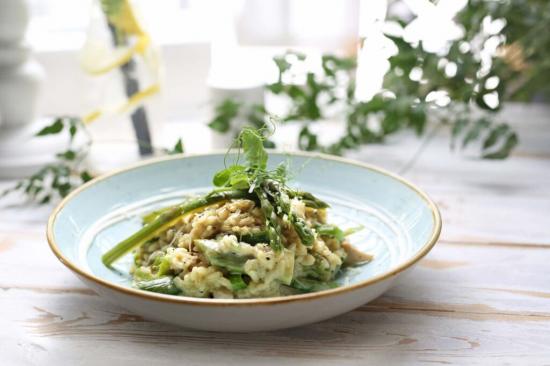
RECIPE – Oat Risotto
Risotto with oats? I would be skeptical, too, but you will be pleasantly surprised by how much you will love this twist on risotto. Traditional risotto made with arborio rice is rich and delicious but lacks an abundance of beneficial nutrients. It can also be extremely time-consuming and finicky to make. The substitution of oats helps solve some of the issues you have with a classic risotto.
But why replace the arborio rice with oats instead of brown rice? One reason is that steel-cut oats are more nutrient-dense than brown rice, with three times more fiber and iron, two times more protein, and more B vitamins, potassium, calcium, zinc, copper, manganese, and magnesium. Also, oats—unlike brown rice—require only 25 minutes (compared to 45 minutes for brown rice) to cook, and it’s much easier to develop the traditional thick, creamy, and rich risotto texture. This dish welcomes in spring’s produce of tender asparagus, fresh green peas, and earthy sweet leeks. This quicker, vibrant, and nutritious risotto is guaranteed to deliver big on taste, texture, and delicious flavors.
Nutrition
Oats: Full of soluble fiber (beta-glucan), which has been shown to slow digestion, increase satiety, and bind to cholesterol to excrete it out of the body. Oats also have plant chemicals that act as antioxidants to reduce damaging effects of chronic inflammation.
Olive Oil: Heart-healthy fat that can increase the good cholesterol and reduce triglyceride levels in the body. Packed full of antioxidants to support eye health and anti-inflammatory properties shown to help reduce symptoms of arthritis.
Leeks: Have similar health benefits as garlic and onions, due to being a great source of allicin, the sulfur compound that is antibacterial, cholesterol-lowering and has potential anticancer properties. Leeks also are a great source of a polyphenol called kaempferol to protect against heart disease. They are also a great prebiotic to feed the good bacteria in our gut.
Asparagus: Contains a blend of nutrients to help that help boost energy, cleanse the urinary tract and neutralize excess ammonia in the body. It is high in anti-inflammatory properties from its high amount of antioxidants, including vitamin C, beta-carotene, vitamin E as well as glutathione, which has been shown to slow the aging process and protect our skin from sun damage and pollution.
Arugula: Greens such as kale, spinach, collards, mustard greens, arugula, and chard have been shown to protect bones from osteoporosis, reduce inflammation, support a healthy gut, strengthen the immune system, protect cognition and supply a high number of antioxidants. They are among some of the best cancer-preventing foods.
Green Peas: A great source of plant-based protein, as well as high amounts of fiber to support a healthy digestive tract and iron to aid in adequate cellular oxygenation. The high fiber and protein content can play a role in maintaining desirable blood sugar levels.
Tomato Sauce: A great source of lycopene that helps reduce the risk of cancer and heart disease and protects skin integrity. Cooking tomatoes in a healthy fat (such as olive or avocado oil) increases the amount of available lycopene the body will absorb.
Zucchini: Nutrient-dense vegetable packed full of fiber and water that aids in digestive health. The insoluble fiber helps us stay regular, and the soluble fiber is a “prebiotic” food for the good bacteria to promote a healthy gut. This vegetable’s high amount of zeaxanthin (a powerful antioxidant) also plays a role in preventing oxidative stress to reduce the risk of developing cancer.
Spinach: Greens such as kale, spinach, collards, mustard greens, arugula, and chard have been shown to protect bones from osteoporosis, reduce inflammation, support a healthy gut, strengthen the immune system, protect cognition, and supply high amounts of antioxidants. They are among some of the best cancer-preventing foods.
Basil: Contains a range of protective vitamins such as Vitamins A, C, and K, as well as essential oils with high antioxidant properties due to the phytochemicals that help reduce oxidative stress in the body. These phytochemicals are known to reduce the risk of cancer but also prevent age-related macular degeneration, and support liver and cardiovascular health. A unique component of basil is its ability to enhance and preserve the healthful properties of other ingredients it is combined with.
Garlic & Onions: Considered a prebiotic, it feeds the “good” bacteria in our gut and promotes a healthy digestive system. Research supports that the compounds in garlic and onions, such as allicin, have antioxidant, anti-inflammatory, antimicrobial, and cardioprotective properties. If you chop your garlic 10-15 minutes before using it will have the maximum amount of active allicin







